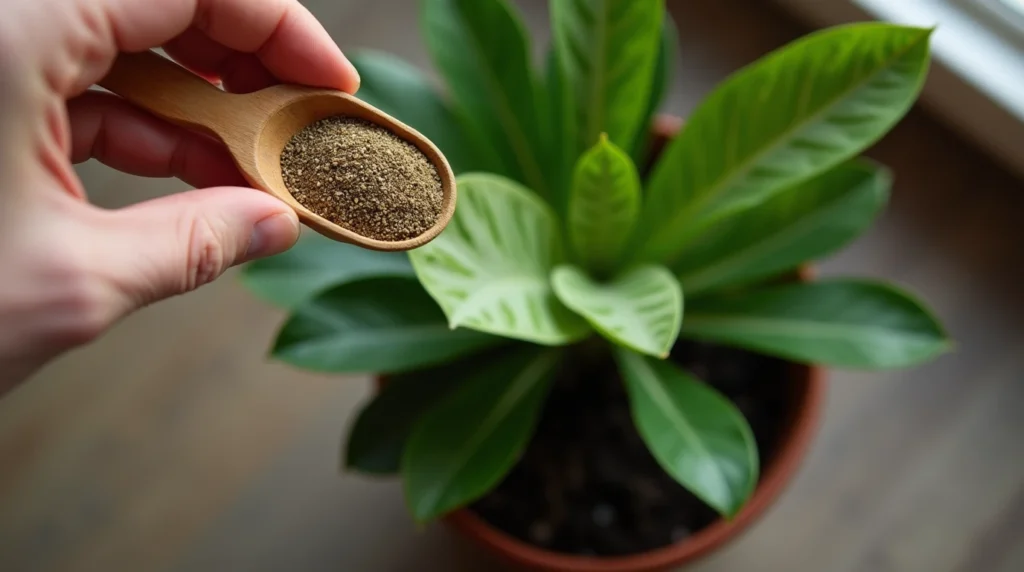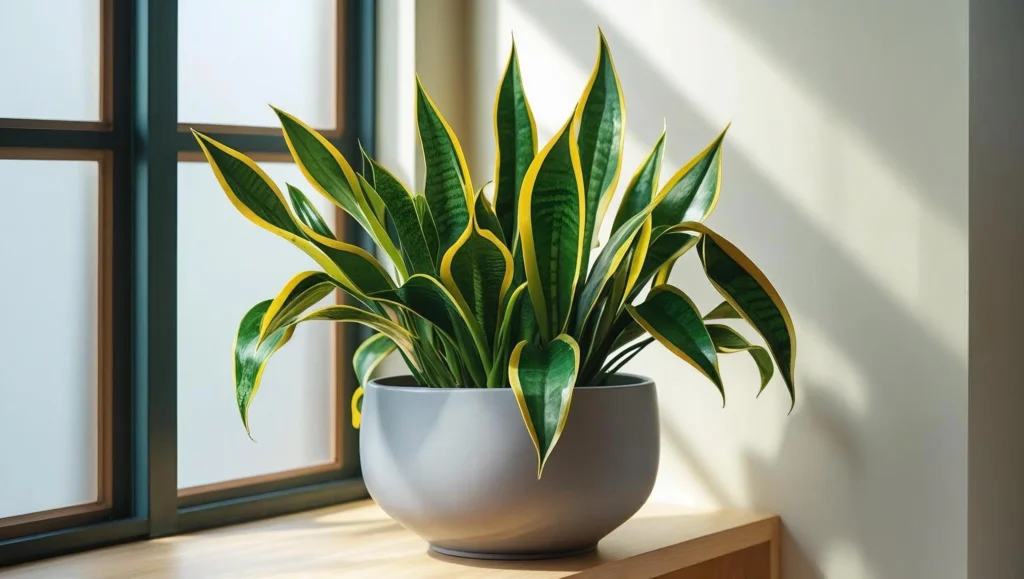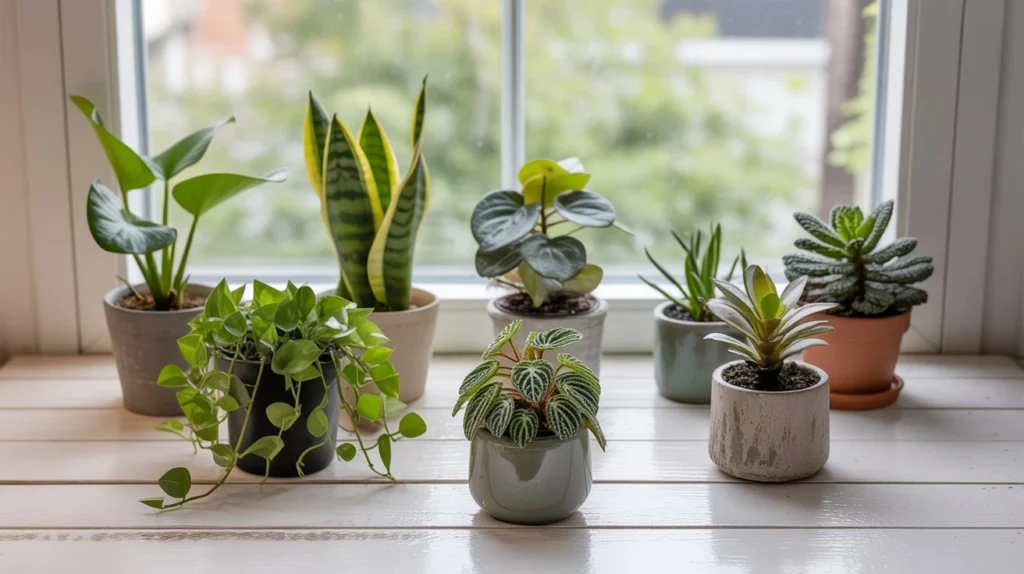
Feeling like your home is missing that special touch of life? Dreaming of lush greenery but convinced you lack the space, the perfect lighting, or the mythical “green thumb”? You’re not alone. Many of us live in apartments with quirky corners, homes with less-than-ideal sunlight, or simply crave the serenity plants bring without the commitment of a towering fiddle leaf fig. The secret? Little plants indoor!
These miniature marvels are the unsung heroes of the plant world. They slip effortlessly onto windowsills, brighten dim desks, add personality to bookshelves, and even thrive in steamy bathrooms. Forget the notion that you need a sprawling conservatory. The right little plants indoor can transform any nook or cranny into a vibrant, living oasis. They purify the air, boost your mood, and bring a piece of nature indoors without overwhelming your space. This guide is your passport to discovering the most resilient, beautiful, and downright charming little indoor plants that will flourish in your unique home, no matter your experience level. Let’s find your perfect petite plant partners!
Table of Contents
Why Little Plants Indoor Are Your Home’s Best Friend
Think small plants are just for decoration? Think again! These compact powerhouses offer a surprising array of benefits:
- Space Savers Supreme: Their diminutive size is their superpower. They fit where larger plants simply can’t:
- Windowsills (even narrow ones)
- Desks and office cubicles
- Bookshelves and mantels
- Bathroom counters and shelves
- Kitchen windows
- Side tables and nightstands
- Beginner Bliss: Many popular small indoor plants are notoriously forgiving. They tolerate occasional missed waterings, adapt to various light levels, and recover well from minor neglect – perfect for dipping your toes into plant parenthood.
- Versatility in Styling: A single tiny succulent makes a statement. A cluster creates a mini-jungle. Their size allows for endless creative arrangements and lets you experiment with different textures and colors without commitment.
- Lower Maintenance (Often): Smaller pots mean less soil, which often (though not always!) translates to less frequent watering needs compared to large, thirsty plants. They’re also easier to move for cleaning or adjusting light exposure.
- Air-Purifying Prowess: Don’t underestimate their impact! NASA’s Clean Air Study highlighted many smaller plants (like Spider Plants and Peace Lilies) for their ability to remove common household toxins like formaldehyde and benzene.
- “NASA’s landmark Clean Air Study highlighted many smaller plants (like Spider Plants and Peace Lilies) for their ability to remove common household toxins…”
- Instant Mood Boost: Greenery, even in small doses, reduces stress, increases focus, and simply makes a space feel happier and more alive.
Top 10 Champion Little Plants Indoor for Every Situation
Choosing the right plant is key to success. Here are 10 superstar little indoor plants known for their adaptability and resilience:
1. The Unkillable Wonder: Snake Plant (Sansevieria trifasciata)
- Why it Thrives: Legendary tolerance for neglect. Thrives on low light (though appreciates medium indirect), infrequent watering (let soil dry completely), and ignores humidity levels. Purifies air exceptionally well.
- Perfect For: Dark corners, bedrooms (releases oxygen at night), forgetful waterers, modern decor. Look for compact varieties like ‘Bantel’s Sensation’, ‘Hahnii’ (Bird’s Nest), or ‘Moonshine’.
- Care: Water sparingly (every 3-6 weeks, less in winter). Avoid soggy soil at all costs. Virtually pest-free.
- Size: Stays compact for years, especially smaller cultivars.
2. The Trailing Charmer: Pothos (Epipremnum aureum)
- Why it Thrives: Adapts to low, medium, or bright indirect light. Tells you when it’s thirsty (leaves droop). Grows quickly but easily maintained small. Trails or climbs.
- Perfect For: Hanging planters (keep small by trimming), shelves, desks, bathrooms. Many stunning varieties: Golden (classic), Marble Queen (variegated), Neon (bright lime), Jade (solid green).
- Care: Water when top 1-2 inches of soil are dry. Appreciates occasional misting but not essential. Trim vines to control size and encourage bushiness. Easy to propagate.
- Size: Starts small; regular trimming keeps it petite.
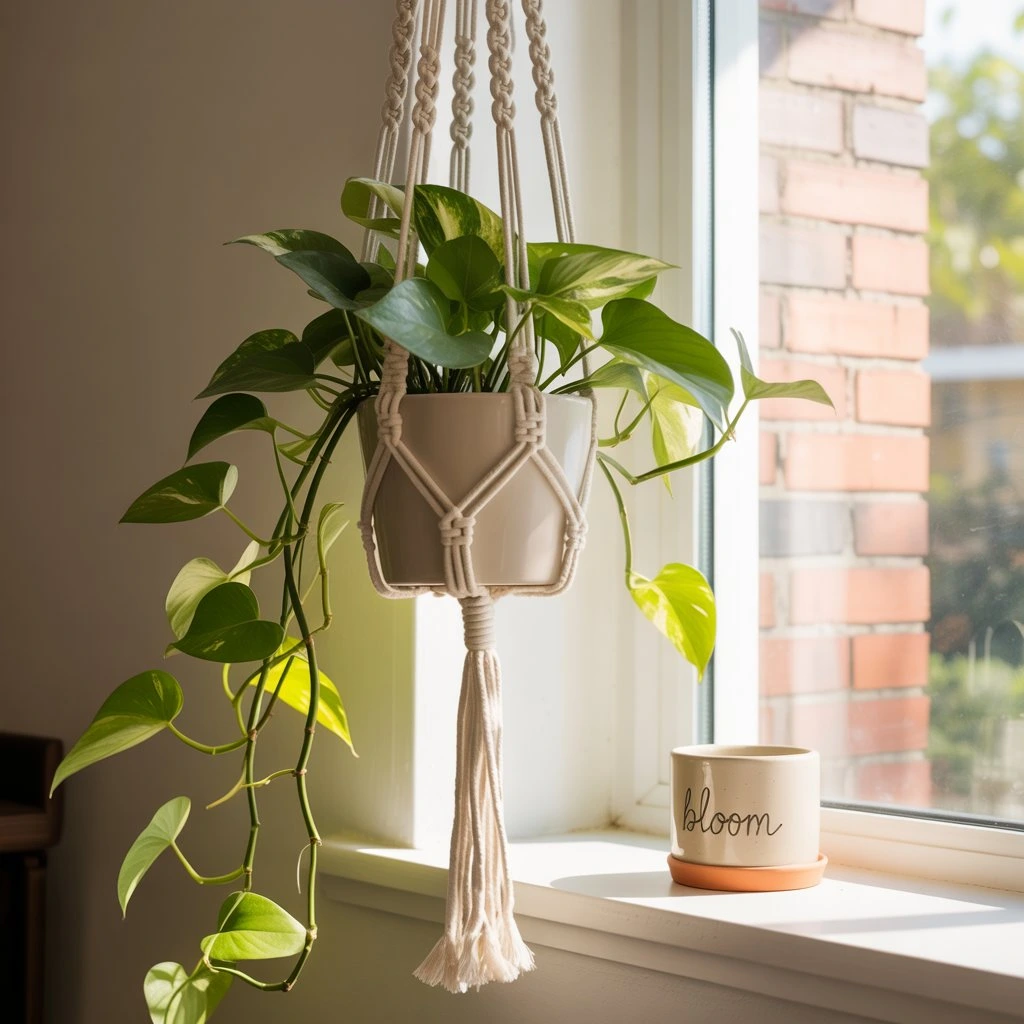
3. The Geometric Gem: ZZ Plant (Zamioculcas zamiifolia)
- Why it Thrives: Thrives on neglect. Tolerates very low light and drought like a champion. Stores water in its potato-like rhizomes. Glossy, architectural leaves.
- Perfect For: Windowless offices, dim hallways, bedrooms, anyone who travels frequently. Modern, minimalist spaces.
- Care: Water very infrequently (only when soil is completely dry, potentially every 4-8 weeks). Overwatering is its only real enemy. Low humidity is fine.
- Size: Slow-growing, stays compact for a long time. Small starter plants are common.
4. The Textural Delight: Peperomia (Various species – e.g., Obtusifolia, Caperata, Prostrata)
- Why it Thrives: Huge variety of leaf shapes, colors, and textures (rippled, succulent-like, heart-shaped, trailing). Generally low-maintenance, preferring to dry out slightly between waterings. Adapts well to medium indirect light.
- Perfect For: Desks, terrariums (some types), shelves, adding visual interest without size. Popular compact types: Watermelon Peperomia, Ripple Peperomia, String of Turtles (trailing).
- Care: Water when top 50-75% of soil is dry. Prefers well-draining mix. Avoid cold drafts. Generally pest-resistant.
- Size: Naturally stay small and compact, rarely exceeding 12″ tall.
5. The Airy Classic: Spider Plant (Chlorophytum comosum)
- Why it Thrives: Very adaptable to light (low to bright indirect). Forgiving with watering. Produces adorable “pups” (baby plants) on long runners. Excellent air purifier.
- Perfect For: Hanging baskets (let the pups cascade), shelves, bright bathrooms. Non-toxic and pet-friendly!
- Care: Water when top inch of soil is dry. Appreciates slightly more humidity but tolerates average home levels. Easy to propagate the pups. Sensitive to fluoride/chlorine – use filtered or distilled water if tips brown.
- Size: Starts small; the rosette stays compact, but pups add trailing length.
6. The Polished Beauty: Chinese Evergreen (Aglaonema modestum / other compact cultivars)
- Why it Thrives: Renowned for tolerating low-light conditions. Slow-growing and stays relatively compact. Beautiful variegated leaves (silver, red, pink patterns depending on variety).
- Perfect For: North-facing rooms, offices, dimmer living areas, adding elegant color. Look for compact varieties like ‘Silver Bay’, ‘Maria’, or ‘Red Valentine’ (needs slightly more light for color).
- Care: Water when top 1-2 inches of soil are dry. Prefers warmth and average to high humidity (but tolerates lower). Avoid cold drafts. Susceptible to mealybugs – inspect regularly.
- Size: Naturally slow-growing; smaller varieties stay under 1.5 ft for years.
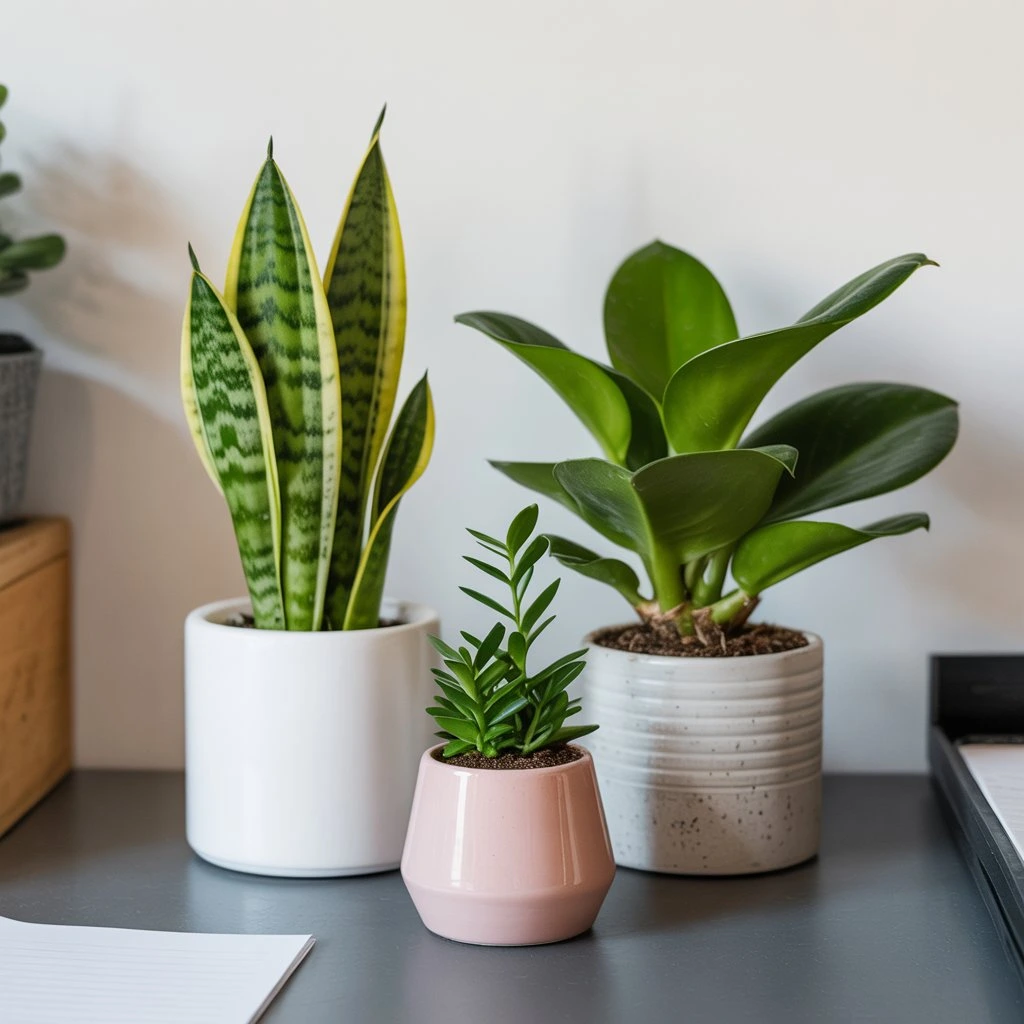
7. The Flowering Friend: Miniature African Violet (Saintpaulia)
- Why it Thrives: Compact varieties stay perfectly small. Bloom repeatedly throughout the year with proper care. Add a lovely pop of color (purple, pink, white, blue).
- Perfect For: Bright windowsills (no direct hot sun), desks with good light, tabletops. Choose specifically labeled “miniature” varieties.
- Care: Prefers bright, indirect light. Water from the bottom (avoid wetting fuzzy leaves) when top soil feels slightly dry. Use lukewarm water. Prefers higher humidity (group with other plants or use a pebble tray).
- Size: Miniature varieties typically stay under 6 inches in diameter.
8. The Tiny Jungle Vibe: Nerve Plant (Fittonia albivenis)
- Why it Thrives: Stunning, intricately veined leaves (pink, white, red). Stays naturally low and spreading. Loves humidity.
- Perfect For: Terrariums, cloches, bright bathrooms, kitchens, or grouped with other humidity-lovers on a pebble tray. A dramatic statement in a tiny package.
- Care: Needs consistently moist (not soggy) soil and high humidity. Will dramatically “faint” when thirsty but usually perks up quickly after watering. Prefers bright, indirect light (direct sun scorches leaves).
- Size: Low-growing, spreading habit, perfect for small containers or terrariums.
9. The Succulent Superstar: Haworthia (e.g., Haworthia fasciata “Zebra Plant”, Haworthia cooperi)
- Why it Thrives: Small, sculptural succulents that thrive on neglect. Prefer bright indirect light and very infrequent watering. Unique and fascinating forms.
- Perfect For: Sunny windowsills (east or west ideal), desks with good light, small plant collections. Very slow-growing.
- Care: Use a gritty, well-draining cactus/succulent mix. Water deeply only when soil is completely dry (every 2-4 weeks, less in winter). Avoid overwatering fiercely. Low humidity is fine.
- Size: Naturally stay small, often only a few inches tall and wide.
10. The Modern Minimalist: Air Plants (Tillandsia)
- Why it Thrives: No soil needed! Absorb water and nutrients through their leaves. Endless creative display options (driftwood, shells, hanging, geometric holders).
- Perfect For: Anywhere with good air circulation and bright, indirect light! Bathrooms (love humidity), shelves, wall art. Choose smaller species like Tillandsia ionantha or Tillandsia stricta.
- Care: Mist thoroughly 2-3 times per week, OR dunk/soak for 20-30 minutes once a week. Shake off excess water thoroughly. Needs excellent air circulation to dry completely within 4 hours. Bright, indirect light is crucial.
- Size: Many species are naturally tiny, perfect for miniature displays.
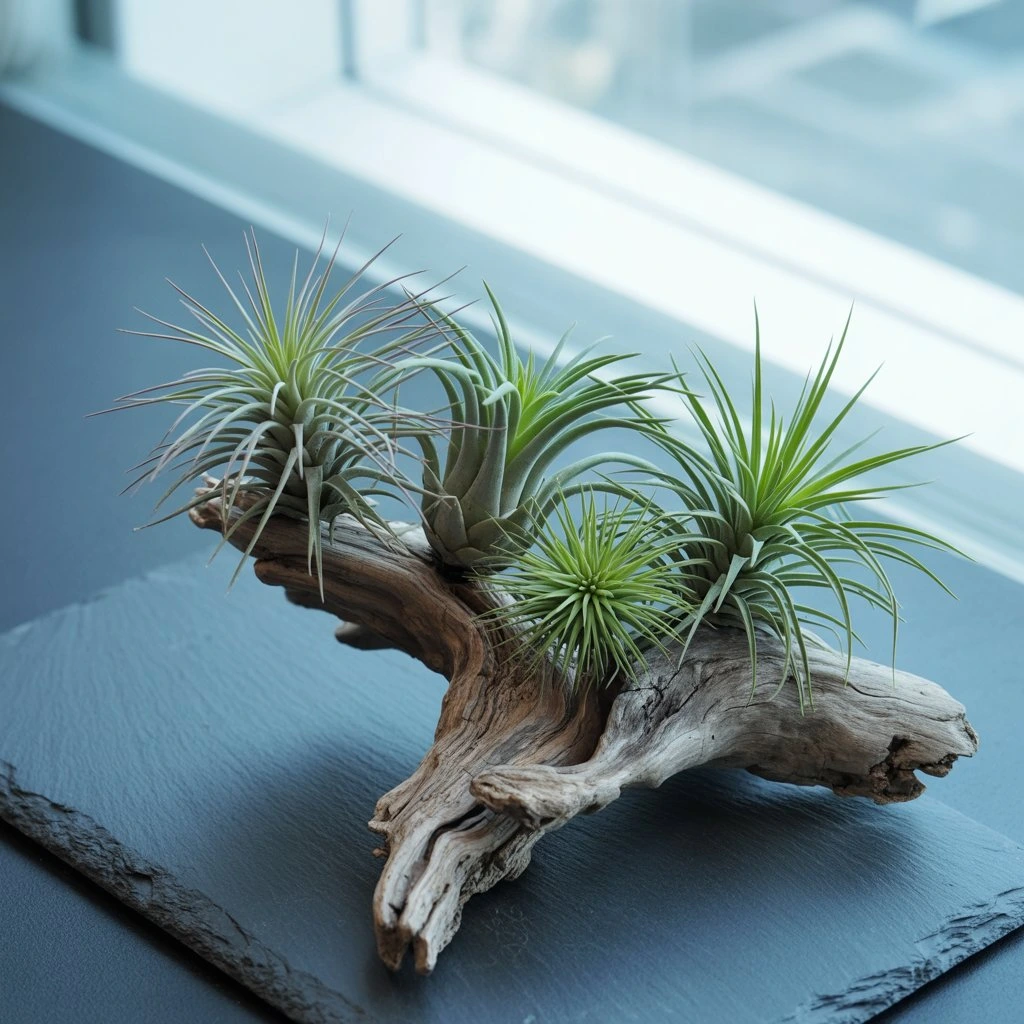
Finding the Perfect Spot: Light & Placement for Little Indoor Plants
Just because they’re small doesn’t mean light isn’t crucial! Matching your plant to its spot is vital:
- Decoding Light Levels:
- Bright Direct: Sunny south/west window (within 1-3 feet). Good for: Haworthias, some compact succulents (like Echeveria minima). Use Caution: Most little plants indoor can scorch here unless acclimated.
- Bright Indirect: East-facing window, or a few feet back from a south/west window. Filtered light (sheer curtain). Ideal for: Most of our champions – Pothos, Peperomia, Spider Plant, mini African Violets, Nerve Plant (with humidity), Air Plants.
- Medium Light: Further back in a bright room (5-8 ft from window), north-facing window sill. Tolerant Plants: ZZ Plant, Snake Plant, Chinese Evergreen, Pothos (slower growth), some Peperomias.
- Low Light: Dim corners, rooms with small/no windows, several feet from a north window. Champions: Snake Plant, ZZ Plant, Chinese Evergreen (best options). Note: “Low light” doesn’t mean no light. All plants need some light! Supplement with grow lights if needed.
- Creative Placement Ideas for Little Plants Indoor:
- Windowsills: The classic! Group compatible plants together.
- Shelves & Bookcases: Layer plants at different heights. Use trailing plants (Pothos, String of Turtles) on higher shelves.
- Desks & Tables: Instant mood boosters. Choose forgiving plants like Snake Plant, ZZ, or Pothos.
- Bathrooms: Leverage humidity! Great for Pothos, Spider Plants, Air Plants, Nerve Plants (if light is sufficient), mini ferns.
- Hanging Planters: Save surface space. Ideal for trailing Pothos, Spider Plants, String of Hearts.
- Terrariums & Cloches: Create mini ecosystems perfect for humidity lovers like Fittonia, small ferns, or moss.
Essential Care for Thriving Little Plants Indoor
While generally easier, these little gems still need basic TLC:
- Watering Wisdom (The Golden Rule): Overwatering is the #1 killer of houseplants, big or small! Always check the soil before watering.
- Finger Test: Stick your finger 1-2 inches into the soil. If it feels dry, water. If moist, wait.
- Weight Test: Lift the pot. Light = likely needs water; Heavy = still moist.
- Plant-Specific Needs: Succulents/Haworthia/ZZ/Snake Plant: Water infrequently, let soil dry completely. Pothos/Spider Plant/Peperomia: Water when top 1-2 inches dry. Nerve Plant/Fittonia: Keep consistently moist (not soggy). African Violets: Bottom water when top feels slightly dry.
- Water Thoroughly: When you water, do so until water runs freely out the drainage holes. Discard excess water in the saucer after 15-20 mins. Drainage holes are non-negotiable!
- The Right Foundation: Potting Mix
- General Purpose: Works for Pothos, Spider Plant, Peperomia, Chinese Evergreen. Ensure it’s well-draining.
- Cactus/Succulent Mix: Essential for Haworthia, ZZ Plant, Snake Plant (they prefer faster drainage). You can add extra perlite to regular mix.
- African Violet Mix: Specifically formulated for their needs – light and airy.
- Terrarium Mix: Usually lighter and designed for high-humidity environments.
- Humble Homes: Pots & Repotting
- Size: Little plants need little pots! Only size up 1-2 inches in diameter when roots are visibly circling the pot or growing out the bottom. Too big a pot holds too much moisture.
- Material: Terracotta breathes well (good for succulents/hardy plants). Ceramic/plastic retains moisture longer (good for thirstier plants like Fittonia). Ensure drainage holes!
- Repotting: Best done in spring/summer. Gently loosen roots, place in new pot with fresh soil. Water well.
- Feeding Your Friends: Fertilizing
- Less is More! Little plants in small pots need less fertilizer.
- Dilute: Use a balanced liquid houseplant fertilizer (e.g., 10-10-10 or 20-20-20) diluted to half or quarter strength.
- Frequency: Fertilize actively growing plants (spring/summer) every 4-6 weeks. Stop fertilizing in fall/winter.
- Humidity Hacks (For Those That Crave It):
- Group Plants: Creates a microclimate.
- Pebble Trays: Place pot on a tray filled with pebbles and water (pot sits above water line).
- Misting: Provides temporary relief (best done in morning). Not sufficient alone for high-humidity lovers like Fittonia.
- Humidifier: Most effective solution for consistent humidity.
- Bathroom/Kitchen Placement: Leverage naturally humid rooms.
Troubleshooting Common Little Plant Problems
Even champions face challenges. Here’s how to diagnose and fix common issues:
- Yellowing Leaves:
- Older Leaves: Natural aging. Prune off.
- Widespread/Yellow + Droopy: Often Overwatering or poor drainage. Check soil! Stop watering, ensure drainage holes.
- Yellow + Crispy Edges: Underwatering, low humidity, or fertilizer burn/chemicals in water (common in Spider Plants). Adjust watering, increase humidity, use filtered water.
- Brown Tips/Edges:
- Low Humidity: Very common (especially Fittonia, Spider Plant). Increase humidity.
- Underwatering: Soil drying out too much between waterings.
- Chemical Buildup: Fluoride/chlorine in tap water (Spider Plants, Dracaena). Use filtered, distilled, or rainwater.
- Over-Fertilizing: Flush soil with water.
- Drooping Leaves:
- Thirsty Plant: Soil is dry (Pothos, Fittonia famously droop dramatically when thirsty). Water thoroughly – they usually perk up fast.
- Overwatered Plant: Soil is soggy, roots may be rotting. Stop watering, check roots (black/mushy = rot), repot if salvageable.
- Leggy Growth / Stretching:
- Insufficient Light: Plant is reaching for more light. Move it closer to a light source or supplement with a grow light. Prune leggy stems.
- Pests (Mealybugs, Fungus Gnats, Spider Mites):
- Isolate: Immediately separate the affected plant.
- Identify: Use a magnifying glass. Mealybugs look like white cottony patches. Fungus gnats are tiny black flies. Spider mites cause fine webbing and stippling.
- Treat:
- Mealybugs: Dab with rubbing alcohol on a cotton swab. Insecticidal soap or neem oil spray.
- Fungus Gnats: Sticky traps for adults. Let soil dry out more between waterings (kills larvae). Bacillus thuringiensis israelensis (BTI – e.g., Mosquito Bits) for larvae.
- Spider Mites: Wipe leaves (undersides too!) with damp cloth. Insecticidal soap or neem oil spray. Increase humidity.
- Prevent: Quarantine new plants. Inspect regularly. Avoid overwatering.
Styling with Small Wonders: Making Your Little Plants Shine
It’s not just about keeping them alive; it’s about letting them enhance your space!
- The Power of Grouping: Create visual impact by clustering 3-5 little plants together on a tray, shelf, or windowsill. Mix textures (smooth, spiky, fuzzy) and heights. Use books or small stands to create levels.
- Choosing Pots with Personality: The pot is half the style! Match your decor:
- Minimalist: Clean white ceramic, concrete, simple terracotta.
- Boho: Macrame hangers, woven baskets (use liner pot), colorful glazed pots.
- Modern: Geometric shapes, matte black, metallics (gold, copper).
- Vintage: Mismatched china cups (add drainage!), thrifted ceramic pots.
- Get Creative with Displays:
- Wall Shelves & Picture Ledges: Perfect for small potted plants or air plant holders.
- Hanging Planters: Free up surface space beautifully.
- Terrariums & Wardian Cases: Enchanting miniature worlds.
- Unusual Containers: Teacups (with care), mason jars (for terrariums), small decorative tins (ensure drainage).
- Propagation Stations: Display cuttings in water (Pothos, Spider Plant) in small vases or test tubes – functional and decorative!
Little Plants Indoor: (FAQ)
Q1: What are the absolute easiest little plants indoor for a complete beginner?
A: Start with the trifecta of toughness: Snake Plant, ZZ Plant, or Pothos. They tolerate low light, irregular watering, and various humidity levels, making them incredibly forgiving while you learn.
Q2: Can little plants indoor survive in a room with no windows?
A: No plant can survive long-term in complete darkness. They all need light for photosynthesis. However, Snake Plants and ZZ Plants are champions of very low light conditions (like a room with only ambient light from a hallway or a north-facing window far away). For truly dark spots, you must use a grow light.
Q3: How often should I water my little plants indoor?
A: There’s no one-size-fits-all schedule! It depends on the plant type, pot size, soil mix, light, temperature, and humidity. Always check the soil moisture first. As a general rule, most common little plants indoor (Pothos, Peperomia, Spider Plant) prefer watering when the top 1-2 inches of soil feel dry. Succulents (Haworthia), ZZ, and Snake Plant need the soil to dry out completely. Nerve Plants need consistently moist soil. The finger test is your best friend!
Q4: Why are the leaves on my little plant turning yellow?
A: Yellow leaves are a common distress signal. The most frequent causes are:
- Overwatering: Soggy soil leads to root rot. Check soil moisture immediately.
- Underwatering: The plant is thirsty. Soil will be very dry.
- Natural Aging: Older leaves (usually lower down) yellow and die off naturally. Just prune them.
- Nutrient Deficiency: Less common in small/new plants, but possible if never fertilized. Use a diluted fertilizer during growing season.
- Pests or Disease: Inspect closely for signs of insects or fungal issues.
Q5: Are any little plants indoor safe for cats or dogs?
A: Yes, but research is crucial! Some popular small plants are toxic. Excellent pet-friendly options include:
- Spider Plant (Chlorophytum comosum)
- Peperomia (Most common varieties – double-check species)
- Certain Calatheas/Marantas (e.g., Rattlesnake Plant, Prayer Plant – Note: Some Calatheas can be larger)
- Parlor Palm (Chamaedorea elegans – starts small)
- Haworthia (Succulent)
- Air Plants (Tillandsia)
- Boston Fern (Can stay small with pruning)
- Peperomia prostrata “String of Turtles” (Trailing)
- Cast Iron Plant (Aspidistra elatior – slow-growing, stays compact initially)
Always confirm the specific plant’s toxicity with a reliable source like the ASPCA website before bringing it home if you have pets.
Embrace the Joy of Little Greens
Who knew so much life, beauty, and benefit could come in such small packages? Little plants indoor truly are the gateway to a greener, happier home. From the stoic resilience of the Snake Plant to the delicate drama of the Nerve Plant, there’s a perfect petite companion for every space, light level, and lifestyle.
Remember the keys to success: choose wisely based on your conditions, understand their light and water needs, provide a pot with drainage, and don’t be afraid to get creative with styling. These small wonders ask for so little but give back so much – cleaner air, reduced stress, and that undeniable spark of nature’s magic right inside your four walls.
So, don’t wait for the perfect large space or ideal lighting setup. Start small! Pick one or two of these champion little plants indoor from our list, find them a cozy spot, and enjoy the journey of watching them thrive. You might just discover your new favorite hobby.
Ready to bring some little green magic into your home?
- Which little plant are you most excited to try? Share your top pick (or a photo of your current tiny jungle!) in the comments below!
- Found this guide helpful? Pin it to Pinterest or share it with a friend who needs some plant inspiration!
